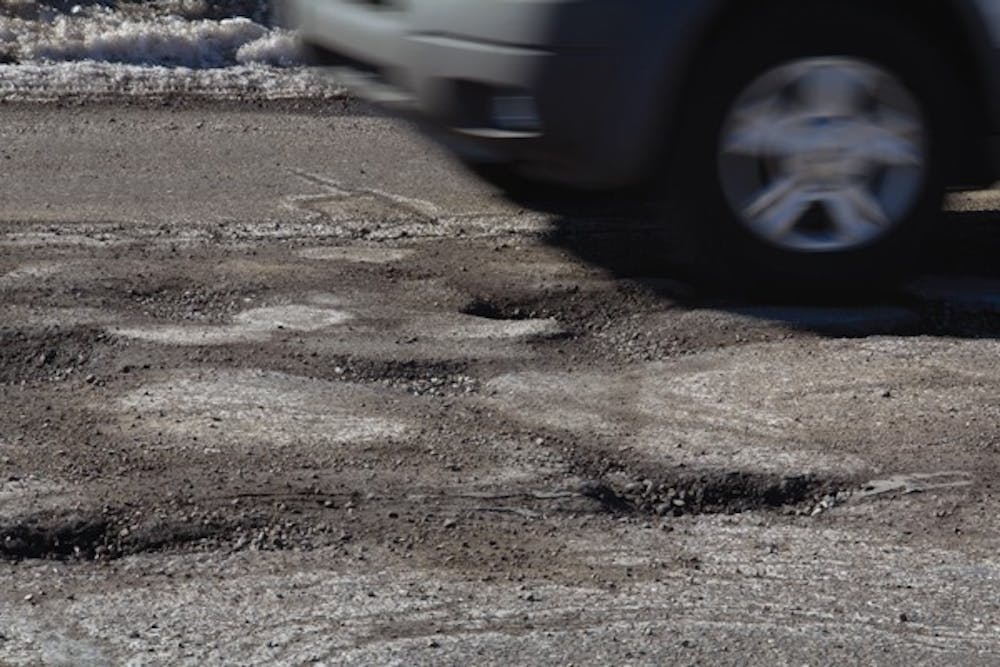Potholes a problem as roadways, parking lots experience freeze, thaw cycles
As the weather grows warmer, evidence of the harsh winter is becoming more apparent on and around campus.
In a number of parking lots and roads within Central Michigan University's main campus, potholes are a persistent problem for drivers. One particularly bad spot for potholes this winter has been Lot 62, located on the east side of the Student Activity Center and Rose Center.
Kara Smith, a Mount Pleasant sophomore, said the potholes in Lot 62 add stress to her morning routine, trying to avoid hitting another car while attempting to dodge potholes.
“With class in the morning, I always have to dodge them,” Smith said. “It’s kind of distracting with other cars coming toward you.”
Crews will be out soon to start filling some of these holes.
Stephen Lawrence, associate vice president of Facilities Management, said the protocol for filling and repairing potholes is dependent on the winter’s changing temperature patterns.
“Potholes develop over time during the freeze and thaw cycle,” Lawrence said. “We usually have to wait until it is warmer, usually above freezing, before we can begin patching.”
The brutal and sporadic nature of Michigan winters have an impact on unpredictable freeze and thaw cycles, contributing to the number of potholes in streets and in parking lots throughout the season.
Matt Weaver, CMU's manager of Landscape Operations, said this winter has not been any worse than previous winters as far ice wedging and pothole creation. Weaver said the continual chill is to blame.
“It’s the fact that it’s been so cold with the amount of snow we’ve been getting, and we haven’t had a lot of sunny days to dry the pavement," he said.
Once the thaw begins, Weaver anticipates potholes to be a bigger problem.
Landscape Operations is responsible for the maintenance of all streets, roads, courts and drives within the university. Maintenance and other repairs, including patching and resurfacing, is paid for by the Facilities Management deferred maintenance budget.
Cleaning Mother Nature's mess
Rationale aside, unfilled potholes present a significant obstacle for student mobility.
Dillon Fassett, a Gladwin senior, also ventures out to Lot 62 and said it's not the size of the potholes that bothers him, but the number of them.
“You can’t really avoid them, because there are so many of them,” Fassett said. “I’m sure it’s not good for any of the cars that are trying to pull in and park here.”
With Lot 62 being as bad as it is, the parking area is a high priority for Weaver, who has his sights on Lots 22 and 33, commuter lots located west of Anspach Hall and east of the Music Building, respectively.
Weaver said once they are able to begin patching, his team will use a pull-behind, asphalt patch unit they can tow around to fill the potholes. The university's asphalt provider, Central Asphalt in Mount Pleasant, is having a hard time providing asphalt because it is still frozen.
“They typically take a loader bucket and try to pop some asphalt loose, then they will put it in their inside storage overnight to warm it up a bit and then give it to us,” he said. “They can’t even get anything broken off their big pile.”
Weaver is hopeful they will be able to patch soon with warmer weather in the future.
The city of Mount Pleasant is responsible for the other roads and streets outside of CMU and throughout Mount Pleasant.
Robert Murphy, street superintendent for the city of Mount Pleasant, oversees the maintenance and other work done to the city's streets and roadways.
Murphy said he sends a few people out to fill in the different potholes around town when conditions clear up. Murphy credited the public for being very helpful in pointing out potentially hazardous potholes.
Like CMU, Murphy's team must wait until the temperature allows the asphalt to settle. If there is a pothole large enough to cause considerable damage to vehicles driving in the area, Murphy said he can patch it as best he can.
“Right now we wait,” Murphy said. “If it’s a big hole, we will get out and take care of it right away. But to try to patch a hole on a cold, bad day, then you are really throwing your material away.”




